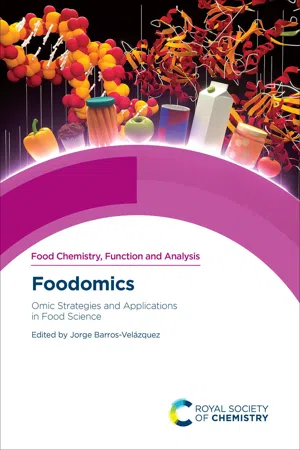
- 496 pages
- English
- ePUB (mobile friendly)
- Available on iOS & Android
About this book
Presenting an up-to-date review of the state-of-the-art and main applications of omics technologies to current hot topics in food sciences, this book is divided into four convenient sections. The first section represents an introduction to the development of foodomics and will provide a general overview of DNA-based and protein-based methods. The second section is focused on the main applications of omics to food safety issues, such as chemical hazards, foodborne pathogens, phages, food authentication or GMO detection. The third section is focused on specific food groups and how omics have revolutionized the investigation of dairy and meat products, seafood, agricultural and fermented food products. Finally, the fourth section is devoted to the link between foodomics and health: hot topics such as nutrimetabolomics, food allergy or probiotics are reviewed here.
The book brings together work from top international scientists to produce the most significant academic book for some years on omics and food for a broad audience. It presents unique features not covered so far by other books, such as a detailed description of different strategies and applications of omics techniques to many food sectors and provides a welcome addition to the cutting-edge literature in this area for researchers and professionals in food science and food chemistry.
Frequently asked questions
- Essential is ideal for learners and professionals who enjoy exploring a wide range of subjects. Access the Essential Library with 800,000+ trusted titles and best-sellers across business, personal growth, and the humanities. Includes unlimited reading time and Standard Read Aloud voice.
- Complete: Perfect for advanced learners and researchers needing full, unrestricted access. Unlock 1.4M+ books across hundreds of subjects, including academic and specialized titles. The Complete Plan also includes advanced features like Premium Read Aloud and Research Assistant.
Please note we cannot support devices running on iOS 13 and Android 7 or earlier. Learn more about using the app.
Information
1.1 Introduction
1.2 Principles and Fundamentals of Foodomics
Table of contents
- Cover
- Title
- Copyright
- Contents
- Chapter 1 Foodomics – Fundamentals, State of the Art and Future Trends
- Chapter 2 DNA-based Omics in Food Science
- Chapter 3 Protein-based Omics in Food Science
- Chapter 4 Application of Chemometrics in Food Analysis
- Chapter 5 Omics for the Identification and Characterization of Foodborne Pathogens
- Chapter 6 Omics for the Investigation of Bacteriophages in Foodborne Bacteria
- Chapter 7 Application of Toxicogenomics for the Risk Assessment of Chemicals in Foods
- Chapter 8 Omics and Food Authentication
- Chapter 9 Application of Omics-based Miniaturized Systems in Food Quality and Safety
- Chapter 10 Omics-based Detection, Identification and Quantification of GM Food and Feed: Current Challenges and Perspectives
- Chapter 11 Omics of Lactic Acid Bacteria for Fermented Food Production
- Chapter 12 Application of Omics in Dairy Science
- Chapter 13 Application of Omics in Meat Science
- Chapter 14 Applications of Proteomics to Food Quality and Safety in Fisheries and Aquaculture
- Chapter 15 Application of Omics in Agricultural Sciences: Wheat Genome Wide Association Studies Causality Analysis
- Chapter 16 Nutrimetabolomics: Concepts and Applications
- Chapter 17 Application of Metabolomics to Food Systems
- Chapter 18 Application of Omics to Probiotic Bacteria for Human Nutrition and Health: The Case of Bifidobacteria
- Chapter 19 Application of Omics to the Investigation of Food Allergy
- Subject Index